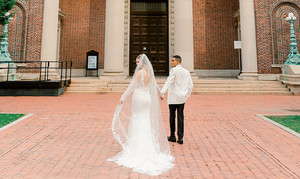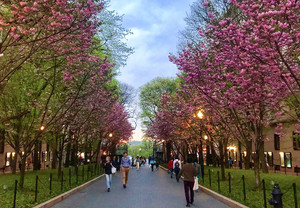They took the stage dressed in silky high-collared Chinese shirts, blue jeans, and white sneakers. Each performer held a pair of sticks connected by a length of string, along which spun an hourglass-shaped spool about the size of a pineapple.
On this Saturday night in October, 120 young adults had shown up at the Roone Arledge Auditorium to attend an anti–domestic violence dinner benefit hosted by Kappa Phi Lambda, an Asian-interest sorority. At buffet tables, guests heaped Styrofoam plates with fried rice, noodles, and spicy string beans made in Chinatown before sitting down for a night of performances.
The students onstage were members of the Chinese Yo-Yo Club. In a choreographed routine set to two music remixes (one from the soundtrack of the movie Amélie), the group members spun, tossed, and caught the spools, called diabolos. The audience shouted and high-clapped for the “whips” (whip-rolling the diabolo at a high point midair), the jump-rope–style jumps accompanied by high tosses, and the round-the-leg “orbits.” When a diabolo was dropped, the crowd responded with silence.
Vincent Liao ’11CC, a computer engineering major and president and cofounder of this satellite club within the Chinese Students Club (CSC), took center stage for his solo. In the early 19th century, diabolo, a descendant of the traditional Chinese yo-yo (itself dating at least to the end of the Eastern Han Dynasty, 25–220 AD), was an especially upper-class fad in France and Britain. In 1905, a Frenchman named Gustave Philippart trademarked the term diabolo in Britain, helping to revive the game. Now, a century later, Liao was showing how far the sport had come.
Moving his arms before him, Liao set a white diabolo spinning on a vertical plane. Then, to oohs and aahs, he lassoed it again and again in midair. In diabolo-speak, the trick is a behind-the-back vertax genocide followed by a triple vertax genocide. (Vertax is short for vertical axle; genocide refers to a player releasing one stick, catching the yo-yo on the string, and then catching the stick.) The night before, during an outdoor performance at Night Market, the CSC’s annual party on Low Plaza, Liao had flubbed the trick. Tonight, he was master.
Liao is tall and slender, and usually wears a T-shirt, rectangular eyeglasses, and an easy smile. His Twitter feed says things like “what keeps a train on the tracks while it’s turning, explained by richard feynman” and “mahjonggggg.” He speaks politely and slowly, in contrast to the whizzing machinery that he and his 20 or so regular members of the club like to set in motion.
Liao taught himself diabolo by watching video tutorials on YouTube and practicing for hundreds of hours. But, as Columbia’s players know, the activity requires not only good hand-eye coordination and a stomach for repetition — learning a trick can take six months — but that most elusive commodity in New York City: ample space. Especially in winter, when cold weather precludes any outdoor practice.
“If you’re doing a vertax, you probably want, to be safe, a 15-by-15 space,” Liao says. “You could probably do with 10-by-10 or 12-by-12. For a ceiling, if you’re not going to toss or do any suicides” — a suicide means the release of one stick — “it’s possible to do it with an 8-foot ceiling. If you want to do some tossing, at least 15.”
The club reserves the bigger spaces on campus, but even these have their drawbacks: John Jay’s piano lounge (ceiling: 22 feet) has two columns in the center of the room, plus there’s a chandelier; Wien’s piano lounge (ceiling: 19 feet 5 inches) also has a chandelier; room C555, in Lerner, has a ceiling of only 16 feet; and the Lerner Party Space is divided into two areas, a smaller one with an 18-foot 4-inch ceiling interrupted by lighting fixtures and a staircase, and a larger one with free-and-clear air space, but a ceiling of only 8 feet.
So what is the ideal space? The consensus is Roone Arledge Auditorium (with ceilings of 30 feet on the stage and 36 in the main room), where the diabolo-ists will perform in February as part of Lunar Gala, the annual Chinese New Year celebration hosted by the CSC.
But Liao looks forward to the spring, when the club can practice outdoors again. The favorite spots are Lewisohn Lawn and the South Lawn.
“We like the exposure,” Liao says. “People see us.”


